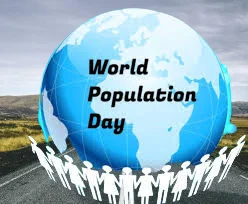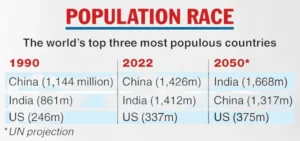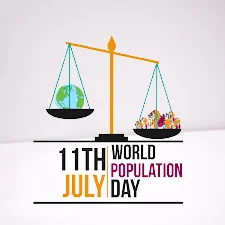World Population Day: World Population Day is observed on 11th July every year. World population day is an annual event observed globally. World Population Day seeks to focus attention on the urgency and importance of population issues. World population day aims to increase people’s awareness on various population issues such as the importance of family planning, gender equality, poverty, maternal health and human rights.
World Population Day
World population day was inspired by the Day of Five Billion, which was observed on 11 July 1987, the date on which the world’s population reached five billion people. The World population day was started by the Governing Council of the United Nations Development Programme in 1989.

The population of the globe grows by 100 million every 14 months on average. On February 6, 2016, the population of the globe was expected to be 7,400,000,000, and on April 24, 2017, it surpassed 7,500,000,000. In 2019, there were 7,700,000,000 people on the planet.
The idea for the World population day came from Dr. K.C. Zachariah who was working with the World Bank that point of time.
In December 1990, the United Nations General Assembly decided to continue the observation on 11th July every year and 11th July 1990 becomes the first day of observation.
Current estimates indicate that roughly 83 million people are being added to the world’s population every year. Even assuming that fertility levels will continue to decline, the global population is expected to reach 8.6 billion in 2030, 9.8 billion in 2050 and 11.2 billion in 2100.
Since the middle of the 20th century, the world has experienced unprecedented population growth. The world’s population more than tripled in size between 1950 and 2020. The growth rate of the world’s population reached a peak between 1965 and 1970, when human numbers were increasing by an average of 2.1% per year.
During the period from 2000 to 2020, even though the global population grew at an average annual rate of 1.2%, 48 countries or areas grew at least twice as fast: these included 33 countries or areas in Africa and 12 in Asia.
The purpose of World Population Day is to draw attention to the mounting issues that come with an expanding global population. In light of the unsustainable rate at which the world’s resources are being used up, overpopulation is a serious problem. It is important to be aware of how population growth affects development and the environment. The health issues that women experience during pregnancy and childbirth are also highlighted by the growing population, underscoring the necessity of family planning, gender equality, and maternal health.
Population pressure is also putting a strain on society, as horrible crimes against gender equality and human rights, particularly in emerging nations, are occurring more frequently than before. As more people enter the world, abuses like human trafficking and child labour become more common since leadership is already doing a poor job of caring for its residents.
Current World Population
As per the present statistics as on 30th June’2023, the world population stands at approx 8,041,592,168 ( Approx 804 crores ) and increasing by 5 numbers every second. For live updates please visit here.
TOP 20 LARGEST COUNTRIES BY POPULATION
| Sl.No | Country | Population |
| 1 | China | 1456062211 |
| 2 | India | 1421553670 |
| 3 | U.S.A. | 336880849 |
| 4 | Indonesia | 282399610 |
| 5 | Pakistan | 234390316 |
| 6 | Nigeria | 222470562 |
| 7 | Brazil | 217151286 |
| 8 | Bangladesh | 169715867 |
| 9 | Russia | 146121121 |
| 10 | Mexico | 133089014 |
| 11 | Japan | 125332613 |
| 12 | Ethiopia | 124065426 |
| 13 | Philippines | 114091663 |
| 14 | Egypt | 108398818 |
| 15 | Vietnam | 100014360 |
| 16 | D.R. Congo | 98410214 |
| 17 | Iran | 87312933 |
| 18 | Turkey | 87125554 |
| 19 | Germany | 84589250 |
| 20 | Thailand | 70325461 |
Important facts on World Population Day
There should be no discrimination when it comes to offering family planning information and services. All countries must make family planning services available for every citizen.
Mere availability won’t suffice; the services must also be accessible. Information and services must be provided in an ethical and culturally acceptable manner.
Proper communication, good quality, and scientific accuracy must be maintained. Every person must make an informed decision

Right to privacy must be respected regarding family planning. Countries must ensure active participation of citizens when it comes to decision making involving health issues
Those making the policies must be accountable to the people. Family planning is the need of the hour. Proper planning regarding child bearing and birth spacing must be done for a better future.
A woman’s body must be ready to give birth. Adolescent pregnancies can lead to complications. Contraceptives must be used to prevent unplanned pregnancies. The mother’s as well as the unborn child’s health is at stake when it comes to pregnancy. Thus, all possible healthcare measures must be undertaken.
A gap of few years between pregnancies helps the mother’s body to heal. The nutrients lost during the gestation period can be regained. This way, the pregnant woman will be able to provide necessary nutrients to the growing child. Suitable pre-natal and post-natal care should be provided to ensure a healthy mother and child.
Bringing a child in this world is a huge responsibility. Parents need to make financial plans to ensure the child gets adequate healthcare and education. And in today’s times, both, healthcare and education are costly. Thus, financial planning has the power to make or break a child’s future. This is where medical insurance plans can prove extremely important.
While just 10 percent of China’s population—the world’s largest—is over the age of 65, that number is expected to rise to over 33 percent by 2050.
Despite active immigration, Russia has lost 3.7 million people since the beginning of the 1990s, the result of a deteriorating quality of life, rising male mortality, and a decline in the number of women of childbearing age.
A 2017 UN World Populations Prospects report said that in roughly seven years, India’s population will surpass that of China’s. The two countries constitute 37 percent of the world’s total population.
With a population of 1.5 billion, India will be the most populated country in the world by 2100, according to the UN Department of Economic and Social Affairs . Nigeria will show the fastest growth, with a jump from the seventh position to the third.
Tokyo is the largest populated city in the world followed by Delhi ( Tokyo has 37 million inhabitants , Delhi 29 million and Shanghai 26 million ). Click here to check the list of world’s mostly populated continents, cities and countries.
With a population of less than 1,000 people, the European country has the smallest population. Vatican City is also the smallest country with a land area of 121 acres.
Nepal has the highest population of women. About 54.19 percent of Nepal’s population comprises women, according to the United Nations Population Division. There are 1,57,88,000 women in the country, whereas the population of men is 1,33,48,000. It is followed by Hong Kong, where women make up 54.12 percent of the population, and Curacao, where women constitute 54.01 percent of the population.

New Zealand has more sheep than people
According to UN data released in 2018, 250 babies are born in some part of the world every minute, making it more than 130 million a year.
In 1970, there were more young people than old in the world. In 2017, there were more old people than young . By 2050, the numbers are expected to balance out. People aged 60 and above constitute 12.3 percent of the population, and by 2050, this number will increase to 22 percent.
Between 2010 and 2015, life expectancy rose by four years, from 67 to 71. It is estimated to rise to 77 between 2045 and 2050, and to 83 years in the period between 2095 and 2100.
Europe will be the only region with a smaller population in 2050 than in 2017. With 2.1 births per woman, there are not enough babies being born to increase the population, according to the UN.
A 2012 report by the BBC stated that India claims to be the world’s second-largest English speaking country, with 125 million people in the country speaking the language. The United States ranks first.
Africa’s population is set to double between 2017 and 2050. In the next 30 years, Africa’s population will double, according to the UN. Of the additional 2.2 billion people expected in the world, 1.2 billion will be in the continent. The second contributor will be in Asia, adding 750 million people between 2017 and 2050.
Today, about 55 percent of the world population lives in urban areas. This number is set to rise to 68 percent by 2050, according to a 2018 report by the UN’s Department of Economic and Social Affairs. India, China and Nigeria will see a big surge in urbanization.
This level of world population growth with the limited infrastructure is bound to create problems for the minority sector of the society. Globally about 800 women die every day due to pregnancy-related complications and 20 percent of these women are from India.

It is estimated that 30 percent of population growth in the world is because of unwanted and accidentals pregnancies.
An estimated 47 percent of girls in India are married before the age of 18 while globally 46 percent of girls are married off before their 18th birthday.
At present, 41 percent of India’s population is below the age of 20 years of age as compared to 24 percent that makes up a majority of the world’s young population.
From 2017 to 2050, it is expected that half of the world population growth will be concentrated in just nine countries: India, Nigeria, Democratic Republic of the Congo, Pakistan, Ethiopia, the United Republic of Tanzania, the United States of America, Uganda and Indonesia (ordered by their expected contribution to total growth).
More than three-quarters of the world’s population lives in Africa (17 percent) and Asia (60 percent)
Africa’s share of the global population is projected to reach 26 percent in 2050 and could reach 40 percent by 2100.
The world’s population aged 60 or above is growing at a rate of 3 percent per year.
The number of persons aged 80 or over is projected to increase from 137 million in 2017 to 425 million in 2050, and further to 909 million in 2100.
The number of older persons in the world is projected to be 1.4 billion in 2030 and 2.1 billion in 2050, and could rise to 3.1 billion in 2100.
Global fertility is projected to fall from 2.5 children per woman in 2010-2015 to 2.0 in 2095-2100.
Young people ages 10–24 account for about 1.8 billion of the world’s population. Ninety percent of them live in developing countries.
Children under 15 years of age represent roughly one quarter of the world’s inhabitants (26 per cent).
Thanks for visiting read4knowledge. Hope you liked the article on World Population Day. Click here to read more articles.